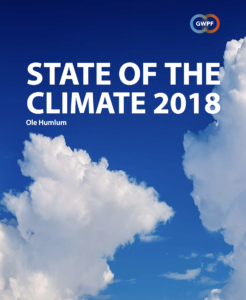by Ole Humlum, April 2022 in GWPF
.pdf, GWPF Report 51, 54 pages
see also here and here
Contents
About the author ii General overview 2021 2
- Air temperatures 4Surface: spatial pattern 4 Lower Troposphere: monthly 6 Lower Troposphere: annual means 7 Surface: monthly 8 Surface: annual means 10 Error, consistency and quality 11 Surface versus lower Troposphere 14Lower Troposphere: land versus ocean 15 By altitude 16 Zonal air temperatures 17 Polar air temperatures 18
- Atmospheric greenhouse gases 19Water vapour 19 Carbon dioxide 20
- Ocean temperatures 22Recent surface temperature anomalies 22 By latitude 24 By depth 25 By region and depth 27 Ocean temperature net change 2004–2020 in selected sectors 28
- Ocean oscillations 31Southern Oscillation Index 31 Pacific Decadal Oscillation 31 Atlantic Multidecadal Oscillation 31
- Sea-level 33In general 33 From satellite altimetry 34 From tide gauges 35 Modelled for the future 36
- Snow and ice 39Global, Arctic and Antarctic sea ice extent 39 Northern Hemisphere snow cover extent 41
- Storms and wind 43Accumulated cyclone energy 43 Other storm and wind observations 45
- Written references 46
- Links to data sources 46
Review process 50 About the Global Warming Policy Foundation 50
…
by Prof. Ole Humlum, April 2 , 2019 in GWPF
That’s according to Norwegian Professor Ole Humlum whose annual review of the world’s climate is published today by the Global Warming Policy Foundation.
Last week, the WMO issued its own review of the climate, which insinuated that global warming was worsening. However, Professor Humlum points out that the data tells a very different story:
“Reading the WMO report, you would think that global warming was getting worse. But in fact it is carefully worded to give a false impression. The data are far more suggestive of an improvement than a deterioration.”
And the lack of anything to be alarmed about is clear across a range of measures, says Professor Humlum:
“After the warm year of 2016, temperatures last year continued to fall back to levels of the so-called warming “pause” of 2000-2015. There is no sign of any acceleration in global temperature, hurricanes or sea-level rise. These empirical observations show no sign of acceleration whatsoever.”
Professor Humlum’s key findings:
- In 2018, the average global surface temperature continued a gradual descent towards the level characterising the years before the strong 2015–16 El Niño episode.
- Since 2004, when the Argo floats came into operation, the global oceans above 1900m depth have on average warmed somewhat. The maximum warming (between the surface and 120 m depth) mainly affects oceans near the equator, where the incoming solar radiation is at a maximum. In contrast, net cooling has been pronounced for the North Atlantic since 2004.
- Data from tide gauges all over the world suggest an average global sea-level rise of 1– 1.5 mm/year, while the satellite record suggests a rise of about 3.2 mm/year. The large difference between the two data sets still has no broadly accepted explanation.
- The Northern Hemisphere snow cover extent has undergone important local and regional variations from year to year. The overall global tendency since 1972, however, is for overall stable snow extent.
- Tropical storm and hurricane accumulated cyclone energy (ACE) values since 1970 have displayed large variations from year to year, but no overall trend towards either lower or higher activity. The same applies for the number of hurricane landfalls in the continental United States, for which the record begins in 1851.
…
see also here

La géologie, une science plus que passionnante … et diverse

